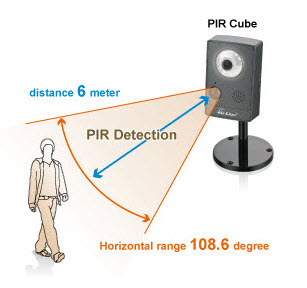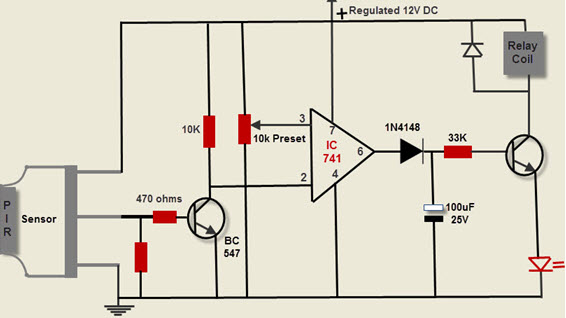Passive infrared sensor
A motion sensor is an electronic sensor that detects motion in its vicinity and thus can work as an electrical switch. Mainly it is used to turn on a light or an alarm.
A motion may be either active with electromagnetic waves (Doppler radar), with ultrasound ( ultrasonic motion detector) or passively work on the basis of infrared radiation of the environment; There are also combinations thereof.
The PIR sensor ( passive infrared English ) is the most widely used type of motion. It is described in the following. It responds perfectly to angle changes, so if a person passes the sensor. In contrast, a Doppler radar optimally responding when changing the distance to the sensor.
Principle of operation
The PIR sensor reacts by taking advantage of pyroelectricity his receiver surface to a temperature change caused by a radiation flux change (primarily by thermal radiation in the mid infrared, wavelengths around 10 microns ) of humans, animals and vehicles in its vicinity. He does not respond to static heat differences, which are caused in a natural way, such as by exposure to sunlight - it can only perceive changing signals, such as when a person enters the detection range of the sensor.
Before the actual sensor is located - in focal distance - a spherical or cylindrical vaulted dome of small collecting lenses from visually whitish, cloudy plastic but this is clearly transparent in the infrared. This multiple lens collects infrared light from a corresponding plurality of discrete sectors on the direction of the small sensor area. Visible light is more scattered back. The sensor sees, depending on the lens arrangement, the environment such as through splayed fingers (vertical ) blind slots or the height of a perforated plate. Now moves an object or creature with a surface temperature sufficiently higher ( rare: lower) than the background across these subjects from the perspective of sectors, and is warm in the infrared therefore brighter surface favorably about as wide as a single visual sector there, the sensor detects the temporal sequence of warm-cold - warm. Because the heat source is sometimes visible, then disappears into the shadows view of a " finger " and appeared in the slit of the next finger gap again. The - slightly delayed due to heat capacity - temperature change at the sensor causes an electrical signal which is processed and amplified to turn about the light via a relay.
In addition to transverse motion to the visual sector and strip the initial occurrence or the sufficiently rapid is coming closer (ie "Greater Will " ) is detected in such a strip. Motion detectors are usually coupled in sensitivity adjustable and with a likewise adjustable dimmer switch. By intent aperture part of the visual sectors can be covered and the sensor module may also be pivoted. A sensor which is itself in the lamp shade is worth going out of this light by timing hardly undesirable as a trigger signal. Biker with exposed skin of motion are often more seen as a closed car with heat resistant glass and air-cooled body. Cooled, well-insulated winter clothes with hood and face Lowered Also, the body heat of a human hide.
PIR sensors receive only radiation emitted by objects and send itself out of no radiation, which is expressed by naming passive infrared sensor. PIR sensors react badly when an object is moving towards them or away from them. This is due to their operating principle, since the motion detection is carried out on the sensor surface due to a temperature change and can be detected better movements transversely to the detection region due to the predominantly transverse lens region. Due to warming end underfloor heating PIR detectors can be falsely triggered.
Motion detectors can lead connections (directly or via a bus system, eg EIB ) to be networked together or by equipment with a radio module. If any of the networked movement responds, turn off all attached a detector their consumers (lights, alarm).
Using as a light switch
An infrared motion detector usually has a built-in dimmer switch, which ensures that the lighting can be switched from the actual motion detector only in darkness. Moves a heat source in front of the detector, so he turns the lights on for an adjustable time period and after the preset illumination time again. Most motion detectors have two adjuster (potentiometer ):
In most motion the counter for the delay time starts when the last motion is detected. If the detector then detects a new motion, it sets the counter to zero. This ensures that the consumer is (eg lighting ) is not turned off when a person stands for long periods of time in the detection area.
In Germany, VDE 0100-410:2007-06 specifies that the PE must be kept otherwise than in the picture to the equipment (detectors ).
There are two-pole and three-pole detector. Bipolar detectors do not require a neutral because they maintain this over the downstream light bulb. They are not suitable for other bulbs. Three-pole detectors require a neutral and turn the subsequent load over a small relay, so all bulbs possible up to the maximum load.
Use as presence detectors
A presence detector is designed to detect the presence of people for seated and other quiet activities. To this end, higher-quality sensors are used which react to the slightest movement. In addition, these detectors are sensitive to changes in the ambient brightness to (eg at the beginning of twilight ) reliably activating the artificial lighting when it falls below a certain threshold.
Presence detectors usually have a second switch channel, which only reacts to movements to control, for example, ventilation and heating, regardless of the brightness.
In order to increase the coverage and ensure that the subjects are located in the more sensitive so-called " internal sensing region ," presence detector should ideally be mounted on the ceiling. In larger rooms, they should be in groups networked to prevent the backlight turns off locally if there are no persons temporarily in a room part.
With each movement is detected, the measurement of the preset time begins at an occupancy sensor from the front, while simpler motion detectors often turn to shutdown again after the set time delay, the first before they respond back to movements. Because of this characteristic presence detector should be able, in spite of the switched artificial light to detect the increase in amount of daylight to turn off the lights when natural lighting illuminates the rooms adequate.
Use in intruder alarm systems
The motion detector used for intruder alarm systems are different from the light - motion. Motion detectors for burglar alarm systems do not use a dusk sensor, since movement should always be reported, regardless of the surrounding brightness. Nevertheless, often in motion for bus systems fitted (eg EIB) twilight sensors, since the detector to perform other tasks while not in intrusion detection system, such as a presence detector. If the burglar alarm system is switched on ( hot), so triggers a movement in the detection area of the detector an alarm. The use of light motion detectors as triggers of intrusion detection systems is not useful, since many motion detectors after failure and recovery of the supply voltage switch on the connected consumer and in this case a false alarm would trigger.
Minimum required connections for intruder alarm systems motion detectors
- Tamper switch
- Opening the case is reported to the burglar alarm panel
- Alarm contact: triggering of the infrared sensor is reported to the burglar alarm panel
- Supply voltage, usually 12 V or, for emergency power supply by a lead-acid battery, and 24 V
Additionally required ports for VdS -certified facilities
- Walk test
- Alarm memory when multiple motion detectors are connected in a zone, the motion sensor is stored, the first triggered
Some models have two separate PIR sensors. An alarm is triggered only when both react at the same time. Thereby the risk of false alarm is reduced. Some models combine a PIR sensor with a microwave sensor (radar motion detector) or an ultrasonic motion detector. These combinations are usually referred to as a dual detector.
With the newer models a -mask is integrated - when the detector is made by an object or Sprühsubstanzen disarmed the alarm system "blind", a message appears on the burglar alarm panel.
Animal -resistant motion detectors are only available for intruder alarm systems. The triggering of this motion detector is slower than normal motion. The installation guidelines for animal resistant motion detectors must be followed exactly in order both to avoid false alarms, on the other hand, to ensure the detection sensitivity. Currently does not have a pet resistant motion detectors a VdS approval.
Use at traffic lights
At traffic signals and on motorways PIR sensors detect the traffic volume to control the traffic signal, to trigger a traffic jam warning or issue a recommended speed. These sensors respond to the heat radiation emitted by the heat of the engine of the vehicle through the vehicle body. PIR sensors are an alternative to inductive loops and require as opposed to those not engaged in the pavement - they are often mounted on traffic light poles or bridges. Construction traffic lights often also have PIR sensors, it can come if no traffic from one side of oncoming traffic longer get green.
Malfunction
In rooms with underfloor heating PIR sensors can not be used because the large-scale heating and the resulting IR thermal radiation is already detected as motion.
Input
The active power consumption is in commercial devices is generally less than 1 watt, but falls through the capacitor power supply a reactive power, which can be compensated with inductive loads such as transformers or motors.










